Implementing NordBord Training Mode for Hamstring Rehabilitation
Available in:
EN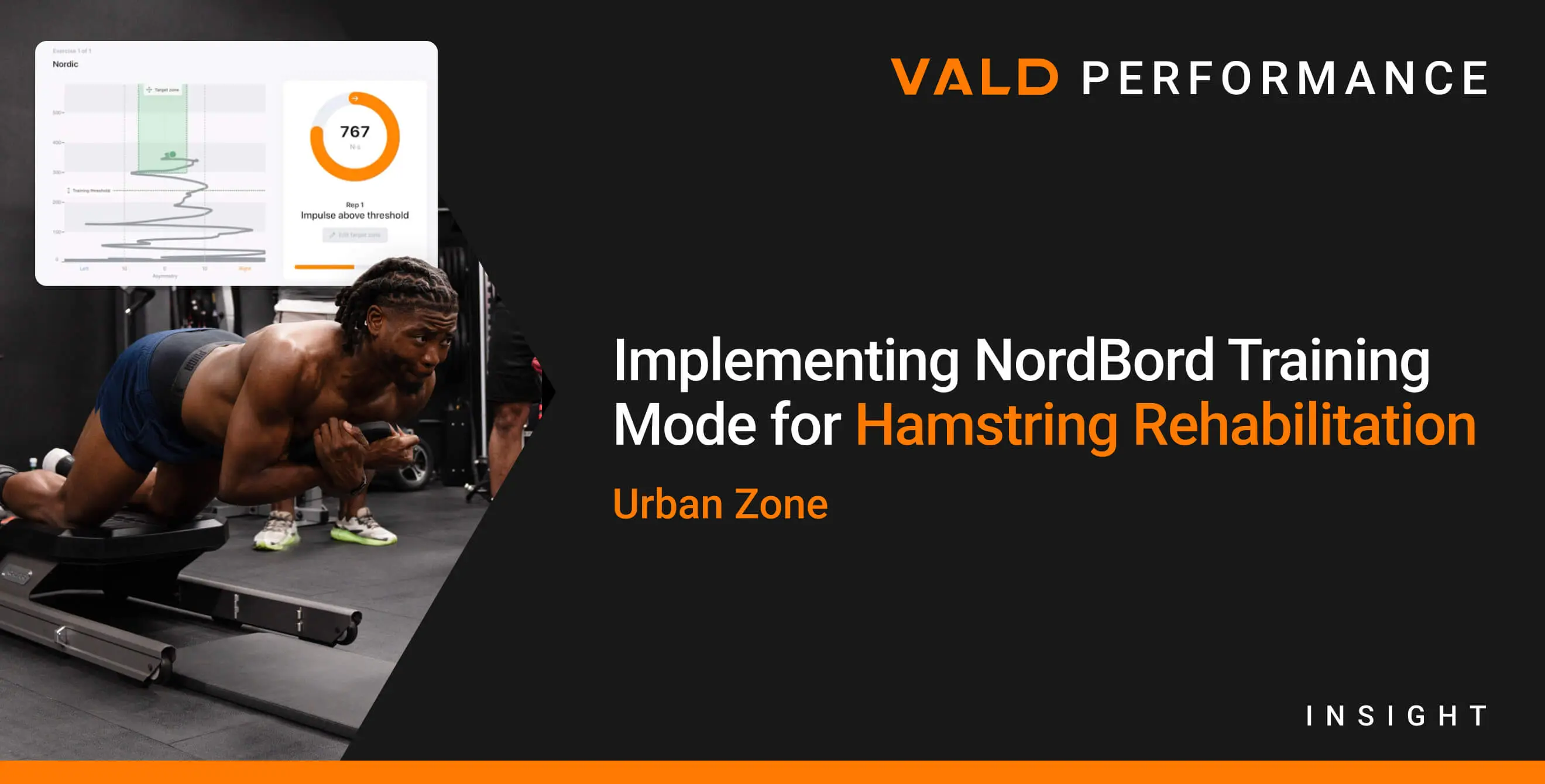
Urban Zone is a leading sports performance facility in Malta, equipped with a full suite of VALD technology, including NordBord, ForceDecks, DynaMo, HumanTrak and ForceFrame. With soccer athletes comprising a significant portion of their clientele, targeted hamstring assessment and rehabilitation is a critical focus.
This case study outlines how Performance Coach and Urban Zone Founder Antheos Spiteri integrates NordBord’s Isometric and Eccentric Training Modes into his rehabilitation process.
Getting Started: From Referral to Testing
Hamstring injuries remain one of the most common and costly injuries in soccer. NordBord helps tackle this issue through fast, objective testing of hamstring strength and inter-limb asymmetry. This results in clear data that guides rehabilitation decisions and monitors athlete progression to keep these acute injuries from becoming chronic.
Hamstring injuries remain one of the most common and costly injuries in soccer …[NordBord can help] keep these acute injuries from becoming chronic.
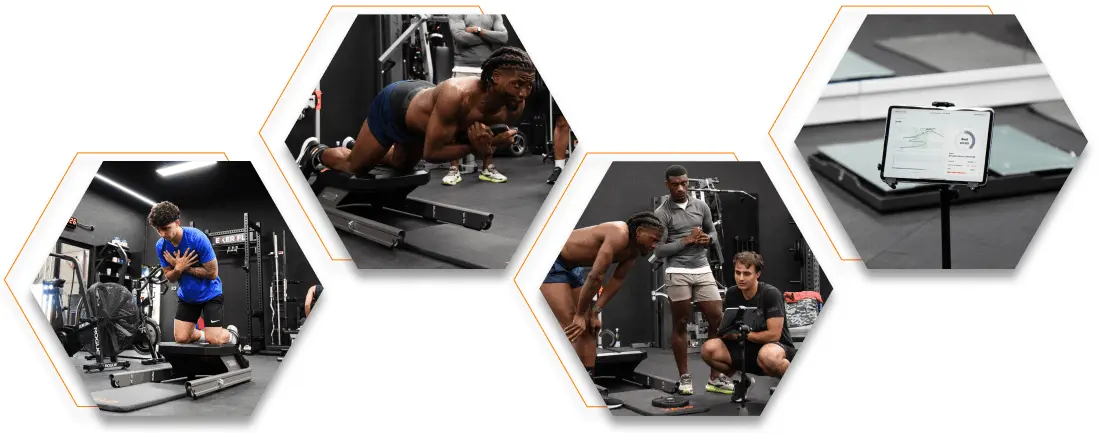
Soccer athletes at Urban Zone performing eccentric testing and training on NordBord.
At Urban Zone, athletes typically enter the rehabilitation process after reporting symptoms post-competition or receiving a referral from a healthcare provider. Objective assessment is one of the first steps they take to ensure a positive rehabilitation outcome.
Initial testing involves either isometric or eccentric assessments on NordBord. These early tests set the foundation for training prescriptions based on measurable neuromuscular performance.
Isometric assessments are commonly used at the beginning of the rehabilitation process, providing a safe and controlled way to evaluate and restore baseline hamstring function. Baseline testing sets the tone and direction of the rehabilitation process, making accurate and reliable data foundational to a quality training prescription.
Baseline testing sets the tone and direction of the rehabilitation process, making accurate and reliable data foundational to a quality training prescription.
Training typically starts at joint angles where the athlete can comfortably tolerate load, minimizing the risk of aggravating symptoms while promoting targeted muscle activation. As the athlete progresses, eccentric loading is gradually introduced to further develop strength and resilience, preparing the hamstring for more demanding sport-specific movements and return-to-play scenarios.
Isometric Training Mode in Action
Isometric training is especially useful during in-season rehabilitation when managing load is key.
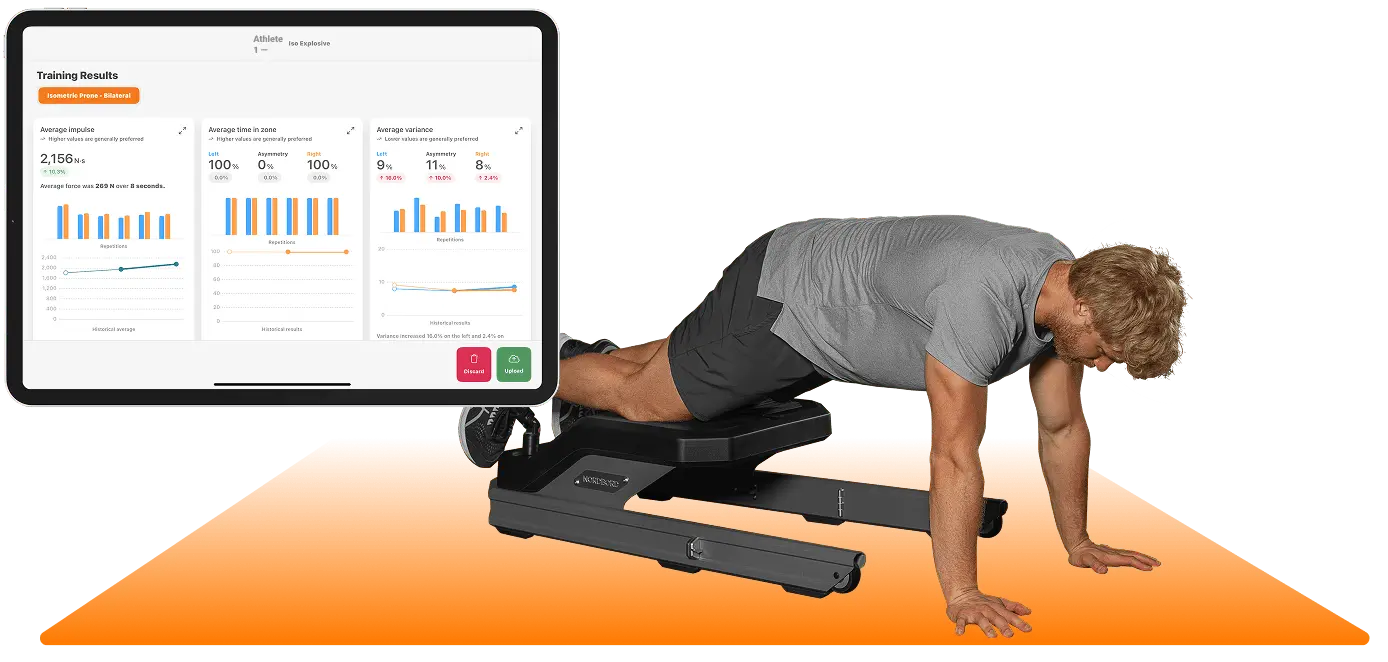
Real athlete data from Urban Zone’s isometric training sessions.
At Urban Zone, isometric training is performed using NordBord at 50-60% of an athlete’s maximal voluntary isometric contraction (MVIC), based on their initial baseline test. Isometrics offer a tendon-friendly, high-feedback method for loading the hamstrings during rehabilitation and in-season training.
Isometrics offer a tendon-friendly, high-feedback method for loading the hamstrings during rehabilitation and in-season training.
The standard training format includes:
- 5 repetitions
- 5-second holds
- 5-second rest periods
This 1:1 work-rest ratio promotes tendon adaptation and reduces unnecessary fatigue.
Similarly, off-season or developmental loading options can be achieved with greater intensity using Eccentric Training Mode. Providing visual feedback on load distribution and setting minimum impulse thresholds for each repetition allows practitioners to drive progression – even when external load or repetition counts remain unchanged.
Practitioners monitor metrics such as impulse and asymmetry to guide future training decisions. Inter-limb asymmetries above 15% are addressed using unilateral holds, targeting the weaker limb until balance is restored.
Athlete performing isometric training on NordBord with immediate results reporting.
Athlete Example: Proximal Hamstring Tendinopathy
In one specific case, an athlete presented with proximal hamstring pain and a 28% inter-limb asymmetry.
Impulse – not just peak force – is a core focus of the program. Because impulse accounts for both magnitude and duration of force, it better reflects the demands placed on the individual when training. By improving impulse symmetry, we ensure that total training load is distributed more evenly between limbs, reducing reliance on one side and promoting better long-term outcomes through more balanced loading.
In response to the significant impairments in force, Urban Zone began integrating Eccentric Training Mode from NordBord, a feature Urban Zone uses widely during preseason and late-stage rehabilitation phases.
Eccentric Training Mode providing visual, limb-specific feedback in real-time with a gray dot shifting laterally based on force output.
This form of biofeedback helps to:
- Visualize asymmetries and total impulse
- Provide cues for force redistribution
- Improve motor control under load
This type of gamified feedback helps athletes correct their force output in real-time, enabling more consistent and efficient neuromechanical loading.
…gamified feedback helps athletes correct force output in real-time…
After integrating Eccentric Training Mode into Urban Zone’s typical training regimen, asymmetries began to reduce significantly, with greater impulse – likely due to increased athlete buy-in and engagement.
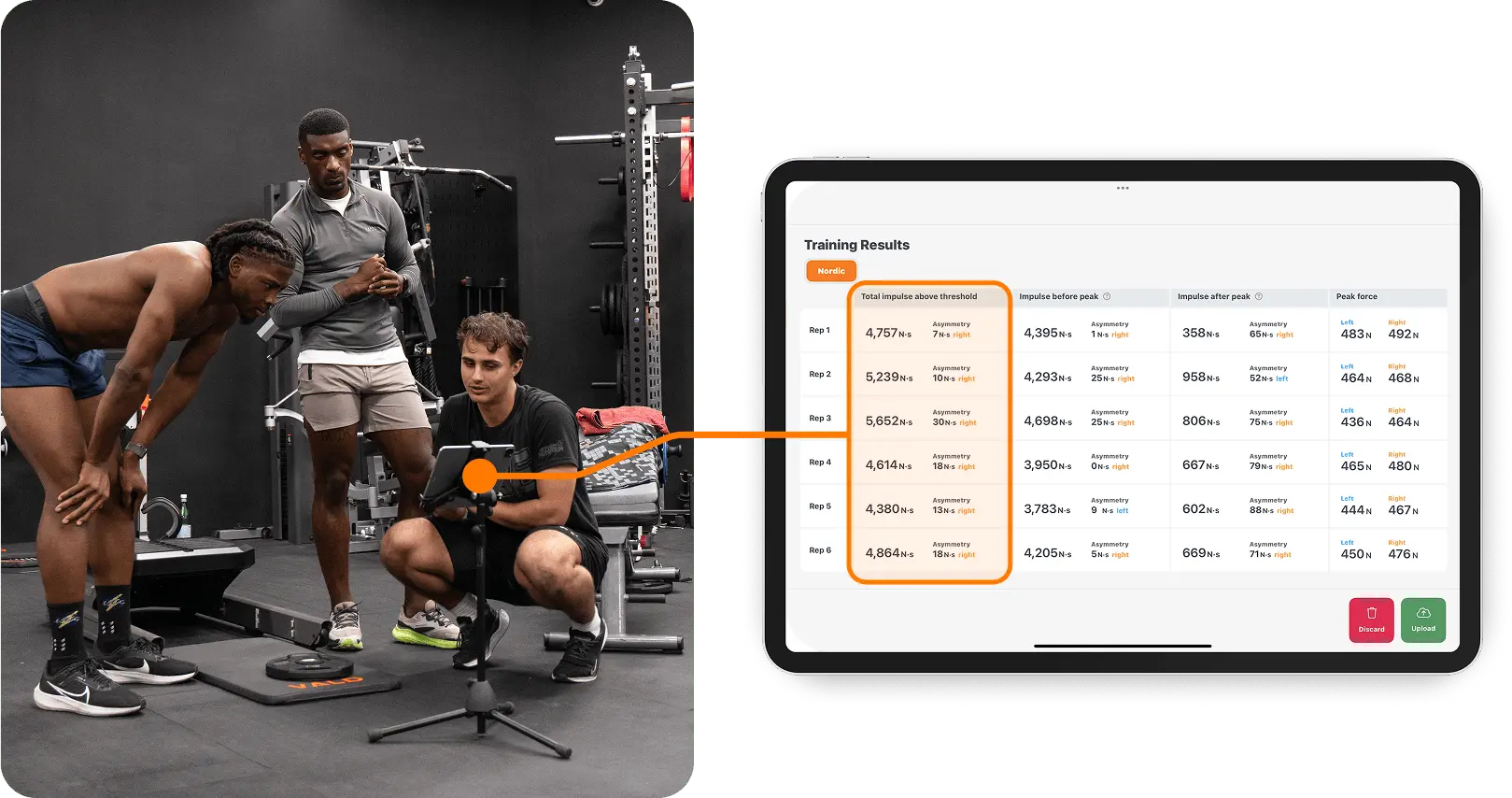
Urban Zone staff educating athletes on impulse-related metrics from NordBord’s Eccentric Training Mode.
Programming Eccentric Training
At Urban Zone, two exercises are used in Eccentric Training Mode:
- Nordic hamstring curl
- Razor curl
The session structure involves the following:
- 6 repetitions
- 30-second rest intervals
- Target zones set at 50-75% of baseline peak force
Athletes are cued to descend slowly until crossing the impulse threshold, then further reduce the descent speed to maintain force within the designated green target zone. If they lose control, they hold the position isometrically at the weakest point – promoting specific strength gains at the angle of failure.
If [athletes] lose control, they hold the position isometrically at the weakest point – promoting specific strength gains at the angle of failure.
To increase difficulty, athletes may hold an external weight during the eccentric repetition. This additional loading, combined with visual cues, helps them correct force asymmetries with supramaximal loads, a core component of high-load neuromuscular control.
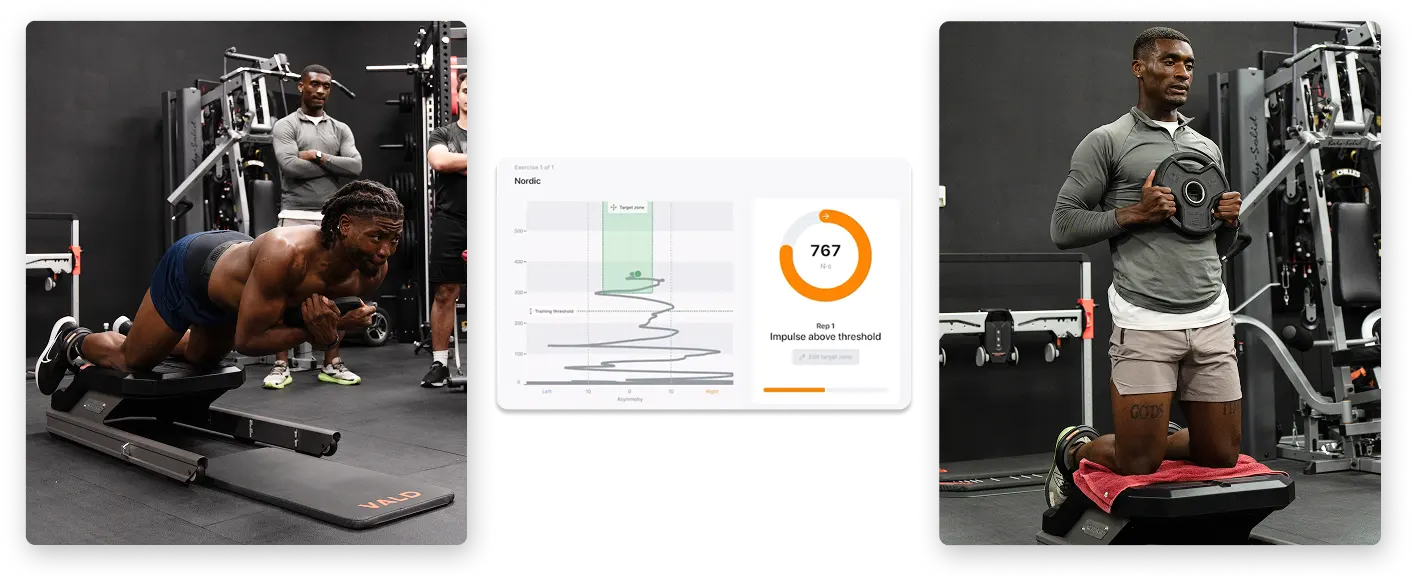
Two athletes performing loaded Nordic hamstring exercises (NHEs) with NordBord Training Mode.
Why This Matters
Eccentric and isometric training strategies are not new for practitioners or athletes – but real-time feedback changes the game. The addition of Training Mode from NordBord helps to refine Urban Zone’s hamstring rehabilitation approach further:
- New Metrics: Practitioners gain access to objective metrics such as impulse and inter-limb asymmetry, which provide a more complete picture of an athlete’s neuromuscular function over time.
- Enhanced Engagement: The system’s gamified interface increases athlete engagement by turning each repetition into a measurable and motivating challenge.
- Biofeedback: Real-time feedback allows for immediate adjustments in motor control and asymmetry, enabling athletes to correct imbalances during the exercise itself.
Eccentric and isometric training are not new…but real-time feedback changes the game.
Importantly, all training is delivered through progressive loading strategies tailored to the athlete’s current capacity, ensuring a safe and effective return to performance.
Together, Isometric and Eccentric Training Modes form a seamless progression. Isometrics allow for early, safe loading and promote tendon health. Eccentrics build strength, control and game-relevant capacity as the athlete progresses.
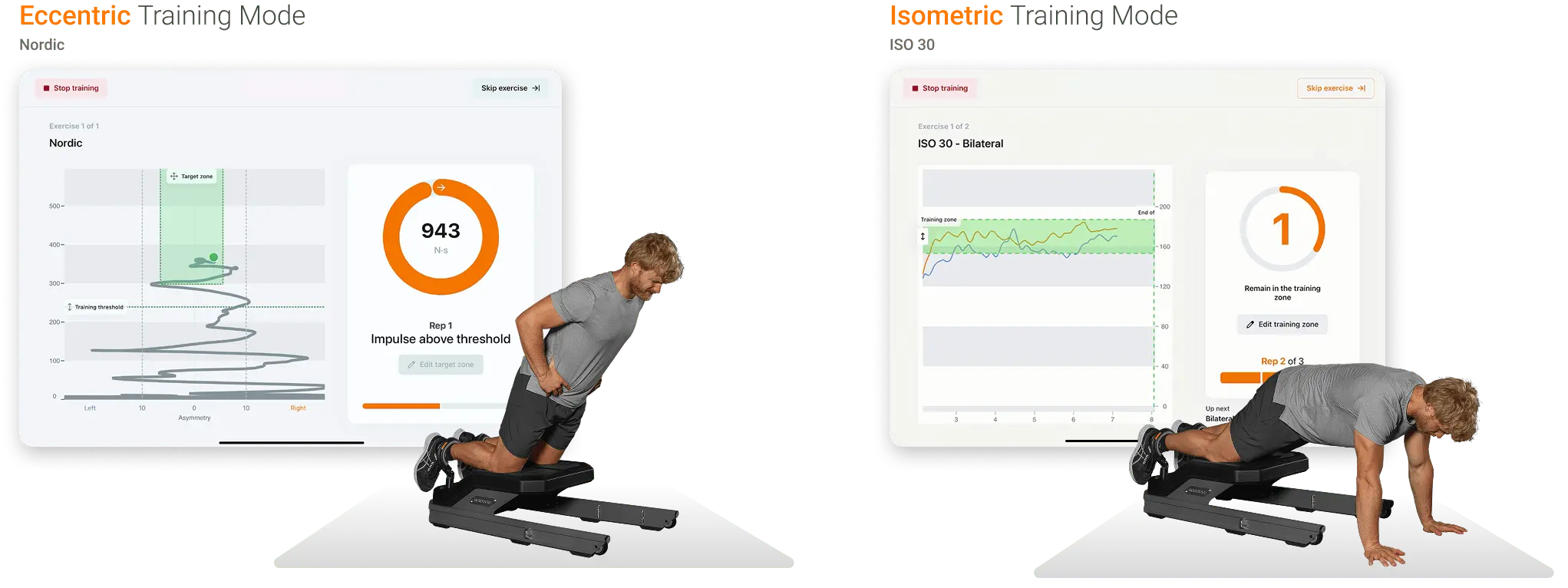
Eccentric and Isometric Training Modes executed with visual feedback.
Key Takeaways
Urban Zone uses NordBord’s Training Mode to support a structured, individualized and evidence-informed approach to hamstring rehabilitation. From delivering real-time force feedback to tracking inter-limb asymmetry and impulse, NordBord offers deeper insights and more targeted interventions than conventional approaches.
Urban Zone’s implementation highlights how practitioners can combine isometric and eccentric loading strategies to restore asymmetry, reduce the risk of reinjury and improve long-term performance outcomes.
To see how VALD technology, such as NordBord, can support your isometric and eccentric training performance, get in touch with our team.
